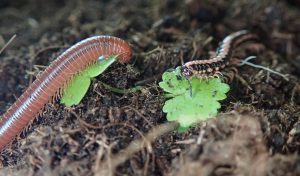CUHK
News Centre
CUHK builds a genome bank of myriapods offering clues to the divergent behaviours of centipedes and millipedes
Biologists at The Chinese University of Hong Kong (CUHK) have sequenced the whole genome of nine centipede and millipede species, of which six were recently completed, constituting the first myriapod gene repertoire analysis in the world. These high-quality reference genomes revealed several unexpected gene alternations that led to divergent behaviours, predatory and detritivorous, of the two myriapod cousins, and provides important insight into the genomic evolution of myriapods. The findings were reported in the prestigious scientific journal Nature Communications.
Both centipedes and millipedes belong to a group of arthropods called myriapods, which means “10,000 feet” in Ancient Greek. There are about 16,000 species of extant myriapods, and they play important ecological roles and recycle nutrients in soil and forest ecosystems. Despite their importance, however, they are the most understudied arthropod lineages.
Professor Jerome HUI, Associate Professor at CUHK’s School of Life Sciences, who was a member of the consortium that published the first centipede genome, has led a research team working on myriapods since 2013, and published the first millipede genome.
Professor Hui explained, “This recent study reveals the divergent pathways followed by centipede and millipede lineages after their divergence from a common myriapod ancestor. This remarkable divergence has led to two very different lifestyles being expressed in extant myriapods: predation in centipedes, characterised by the evolution of offensive chemical weaponry in the form of venom, and a detritivorous diet in millipedes. We provide the first steps towards unravelling the genomic bases of the divergent adaptations underlying these two lineages with very different ecologies.”
Gene transfers further separate ecological features
One interesting finding the team identified is the potential factors that shaped the divergent evolutionary trajectories. Genetic gains in signal transduction were discovered in centipedes, which could well have contributed to sensory and locomotory adaptations that facilitated centipedes’ ecological shift to predation.
Meanwhile, genetic transfer from bacteria to the myriapods was also unexpectedly found in this study. Horizontal gene transfer (HGT) events occurred independently in the ancestors of both centipedes and millipedes, which hypothetically further suggests the divergent adaptive evolution of carnivorous centipedes that possess unique, venom-injecting, claw-like forcipules, and millipedes that feed on mainly leaf litter and act as important nutrients cyclers.
Hormonal gene loss in millipedes results in different physiology
Apart from ecological features, the team also identified a possible contributing factor that made millipedes and centipedes develop major differences in physiology throughout their evolutionary history. The team found that extant centipedes have retained key enzymes that produce sesquiterpenoid hormones from their myriapod ancestor, but these enzymes are absent in millipedes. Since sesquiterpenoid hormones are key candidates to regulate growth and reproduction in animals, this study provides a foundation for further basic and applied research on myriapods.
Dr. Henry SO, first author of the paper, said, “This is just our first step in reconstructing animal genomic evolution, and we believe that we can do better and achieve more in the future.”
Professor Hui added, “In the near future, in addition to continuing to explore the hidden biology and genomics, we need to fully understand the ecological roles in soil and forest ecosystems of this fascinating yet neglected group of organisms. Hopefully one day we can better understand these life forms on land, the effects of climate change on them and their contribution to nutrient recycling, and perhaps eventually achieve zero hunger via agricultural applications.”
Full research paper can be viewed at: https://www.nature.com/articles/s41467-022-30690-0

Trigoniulus corallinus (left) and Helicorthomorpha holstii (right) are two millipede species that are commonly found in Hong Kong. T. corallinus can be easily be spotted on the ground after rain in the spring, while H. holstii can be commonly seen in farm soil, on hiking trails and elsewhere in the countryside in warm and humid seasons.

In addition to the first myriapod genome published in 2013 by an international team, CUHK has sequenced the genome of eight myriapods, which are commonly wild-caught or easily purchased species in Hong Kong. These five millipede species (A: Helicorthomorpha holstii, B: Trigoniulus corallinus, C: Glomeris maerens, D: Anaulaciulus tonginus, E: Niponia nodulosa) and three centipede species (F: Lithobius niger, G: Rhysida immarginata, H: Thereuonema tuberculata) were chosen to represent different myriapod members for the team’s genome sequencing projects.






